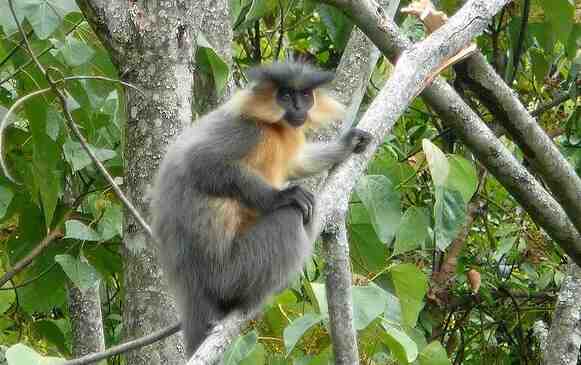Trachypithecus pileatus
IUCN
LCBasic Information
Scientific classification
- name:Trachypithecus pileatus
- Scientific Name:Capped Langur, Hooded leaf monkey
- Outline:Primates
- Family:Primates Cercopithecidae Trachypithecus
Vital signs
- length:53-71cm
- Weight:9-14kg
- lifetime:20year
Feature
The crown is dark in color, like a "small hat" on the head
Distribution and Habitat
Distributed in Bangladesh, Bhutan, India (Assam, Manipur, Meghalaya, Nagaland), Myanmar. In China, it is only found in the Gaoligong Mountain area in northwestern Yunnan (Gongshan, Fugong and the western slope of Gaoligong Mountain in Lushui).
It inhabits tropical and subtropical forests and dense forests in river valleys. It mainly inhabits tropical rainforests, monsoon forests or subtropical evergreen broad-leaved forests, lowland and hilly forests, including deciduous forests, on both sides of rivers and in low mountain valleys below 1,500 meters above sea level. It is found in bamboo forests, teak forests and plantations.
Appearance
The male hooded leaf monkey is 53-71 cm long, with a tail length of 86-100 cm and a weight of 11.5-14.0 kg; the female is 49-66 cm long, with a tail length of 83-96 cm and a weight of 9.5-11.5 kg. The face is black, and the body is silver-gray or yellow except for the ends of the limbs and the tail, which are black. The back hair, the outer side of the limbs and the tail end are dark gray. The top hair is fluffy and has no spiral hair. The crown is dark in color, like a small hat, which is in sharp contrast with the light-colored beard. The face is black, and the skin around the eyes and mouth forms eye circles and mouth rings due to the lack of pigment. The hands and feet are black. The saliva secretion is well developed, and the stomach is pouch-shaped. Its digestive system is adapted to eating leaves, so it does not have cheek pouches like omnivorous monkeys. The newborn cubs are orange or milky white in color, with pink ears, face, hands and feet, which contrasts with the gray and
Details
There are 4 subspecies of the hooded langur, with different fur colors. The Bengal subspecies has orange abdomen, beard and throat; the Bhutan subspecies has a gray collar, a light red abdomen, a black face and a dark gray crown; the Brahman subspecies has a much lighter fur color than other subspecies.

A group of black-capped langurs usually consists of one adult male and several females and their immature offspring. This single system ensures that a dominant male can mate with all the females in the family and must protect the offspring in the family. Other lonely adult males (usually driven out of the original family group after adulthood) and sub-adult males form separate small groups. Some multi-male, multi-female groups have also been found, with the females controlling the family's direction of travel when the group moves or stops to feed, while the males stay behind. They usually move forward in an irregular formation and flee in the same direction when startled. This highly social primate indulges in a lot of play in infancy, and as an adult, uses well-developed vocal communication and strong tactile gestures to convey information to each other during their growth and daily life, including grooming and face-to-face interactive hugs.
When in groups, the capped black leaf monkey is relatively quiet compared to other animals in the same genus, and individuals stay close together unless they encounter a rival family group. The family range is large and often overlaps with other groups. Although males do not defend food sources, they will actively defend their females. All-male groups are particularly aggressive, and they will try to capture females from the family group to form their own family group.
Hooded langurs wake up at dawn but remain in their sleeping tree until the sun rises fully. They may just move to higher branches to soak up the sun before going out to look for food. This species drinks from the hollows of branches and rarely descends to the ground, especially when young. They feed mainly in the early morning and late afternoon and find a suitable sleeping tree at dusk, choosing a different tree each day. Each monkey sleeps individually in a tree, while a mother sleeps with her young.
The Hooded langur population faces a number of threats, especially to its geographical location, habitat loss, most of which is from human development. Some of the main causes are developments such as mangrove planting, plant monoculture, timber and firewood harvesting, loss of fruit trees and trees, lack of edible trees (2003). In addition, humans hunt and trade these animals for their meat and other body parts, as well as for pet keeping.
In March 1986, China's Yunnan Province established the Nujiang Nature Reserve in the distribution area of the hooded black leaf monkey. According to statistics from the Kunming Institute of Zoology of the Chinese Academy of Sciences in 1988, there were only 500 to 600 hooded leaf monkeys left in the Dulong River Valley.
Listed in the IUCN ver3.1: 2008 Red List of Primates - Vulnerable (VU).
Listed as a Class I protected animal in the Convention on International Trade in Endangered Species of Wild Fauna and Flora (CITES).
Listed in the first level of the "List of National Key Protected Wildlife in China".
Protect wild animals and eliminate game.
Maintaining ecological balance is everyone's responsibility!








